 United Kingdom (1897)
United Kingdom (1897)Canopus, Albion, Glory, Goliath, Ocean, Vengeance
WW1 RN Battleships
HMS Dreadnought | Bellerophon class | St. Vincent class | HMS Neptune | Colossus class | Orion class | King George V | Iron Duke class | HMS Agincourt | HMS Erin | HMS Canada | Queen Elizabeth class | Revenge class | G3 classMajestic class | Centurion class | Canopus class | Formidable class | London class | Duncan class | King Edward VII class | Swiftsure class | Lord Nelson class
Invincible class | Indefatigable class | Lion class | HMS Tiger | Courageous class | Renown class | Admiral class | N3 class
Successors of the Majestic
Five ships of a new class of battleships were ordered on the 1896 plan. A sixth was on the 1897 plan. They were defined as faster versions of the Majestic, and at the same time to operate in the Far East to counterpoise especially the growing weight of the Nippon Navy. A real quadrature of the circle was also made, by reducing the thickness of the armor and the total weight of 2000 tons, by using Krupp steel rather than Harvey. Their armor and their artillery disposition remained modeled on those of the Majestic. Their “turrets” were actually relatively light barbettes, made of Krupp steel plates. The loading system was also new and allowed to operate it with parts inclined at all angles. These were also the first British battleships to have water tube boilers. The latter, Belleville, were scarcely heavier than the old ones and they put pressure on 300 bars, as against 155 on the old ones.
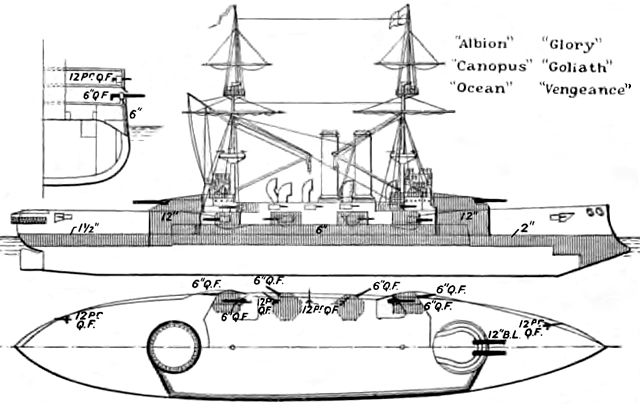
Brassey’s diagram of the class
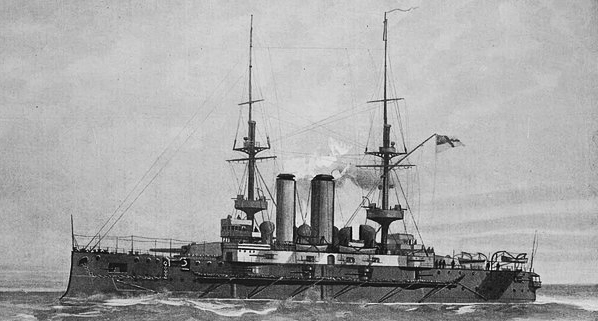
Canopus drawing by Alfred T. janes
The arrangement of these new boilers also made that their funnels were found in tandem and not side by side, provision kept thereafter for the future battleships. Test power reached 13,500 hp and reached speed of 18.5 knots. As expected, their career began with a long stay in the Far East squadron, which culminated after the Japanese victory against Russia in 1905 by a cautious military alliance with the Japanese Empire. As a result of this threat, the British repatriated a number of ships including these battleships into the Home Fleet, to ward off the growing threat of the Hochseeflotte.
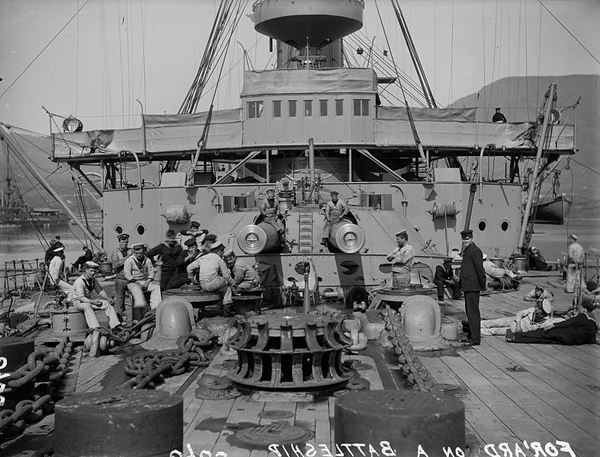
HMS canopus front artillery
HMS Albion
HMS Albion was in the 1906 Sailing Squadron before reemerging in Chatham in 1907. He was posted to the Home Fleet in Portsmouth and then to the Fleet. Atlantic. During the Great War he was sent to South Africa. Then he was assigned to the Mediterranean, bombing the strong Turks at the Dardanelles. He was touched seriously. After repairs, he sent troops to Salonica. Finally, he was stationed as coastguard of the Southeast fleet from the end of 1915 until 1918. He was assigned to Devonport, disarmed and used as a utility pontoon until 1922.
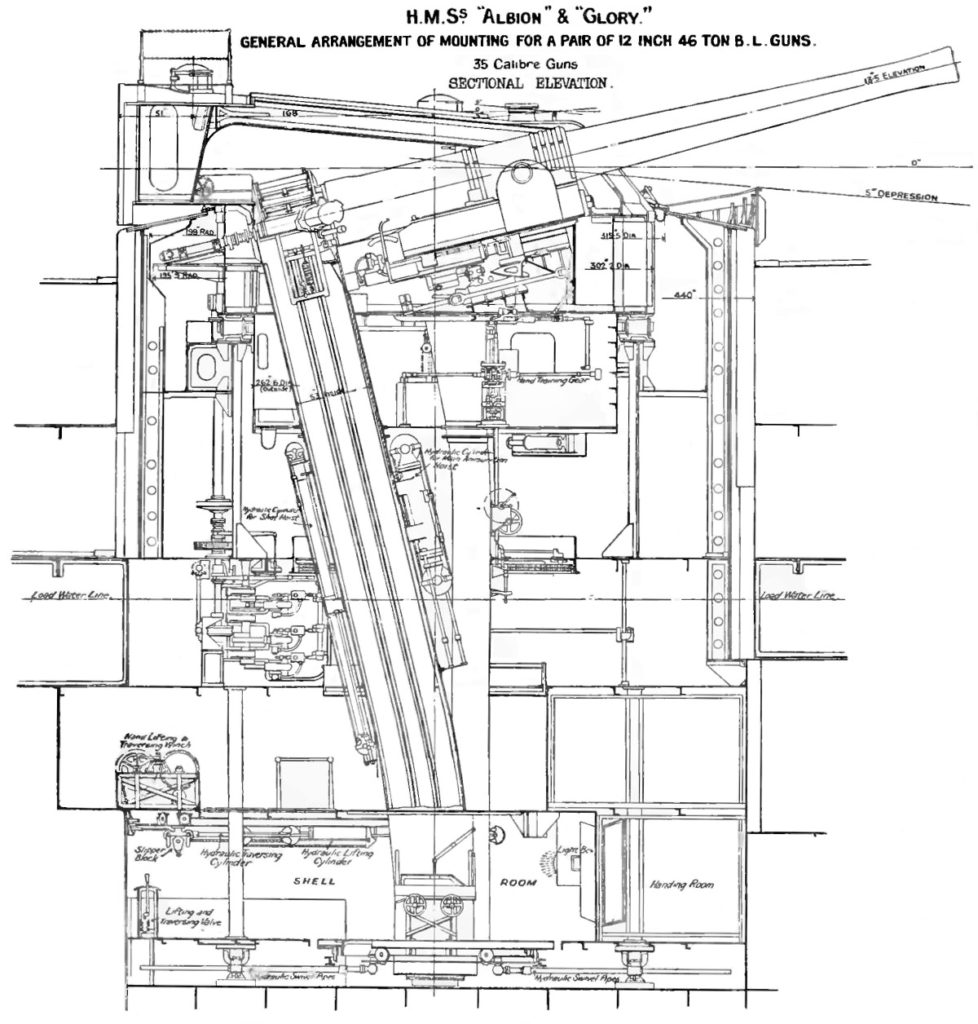
12 inches gun right elevation
HMS Canopus
The HMS Canopus served in the Channel, then in the Mediterranean, and returned to the metropolis, before being assigned to Port Stanley in the Falklands at the end of 1914. He could not take part in the fleet of Cradock which was defeated by the Von Spee squadron, but his guns fired a few later against German cruisers without results. He then rallied to the Dardanelles, then blockaded Smyrna, and returned in 1916 to Chatham, set aside, and sold in 1920.
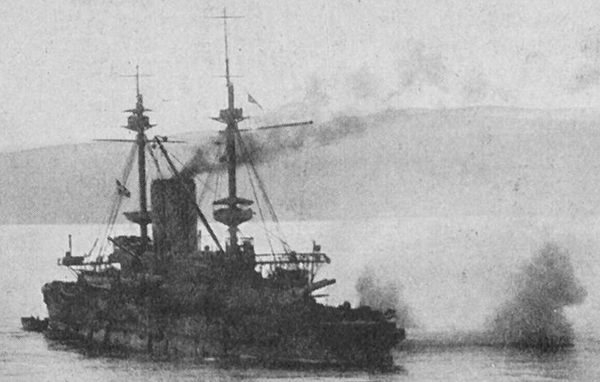
HMS Albion shelling Turkish forts of the Dardanelles
HMS Glory
HMS Glory was sent during the war to North America and then to the East Indies as flagship. He then worked in the Red Sea, then in the Mediterranean, defending the Suez Canal. He then joined Archangel and remained there as a coast guard until 1919 before the sale and demolition.
HMS Goliath
HMS Goliath served in the Channel, then in Scotland in 1914. He covered troop landings in Belgium (Ostend), and in the East Indies, and in November he was on the Rufiji River in Africa, firing the Königsberg. He was sent to the Dardanelles in 1915, to support the operations at Cape Helles, and twice touched. Finally, on the night of May 13, it was torpedoed and sunk by the Turkish submarine Muavenet, sinking in a few moments carrying 570 men.
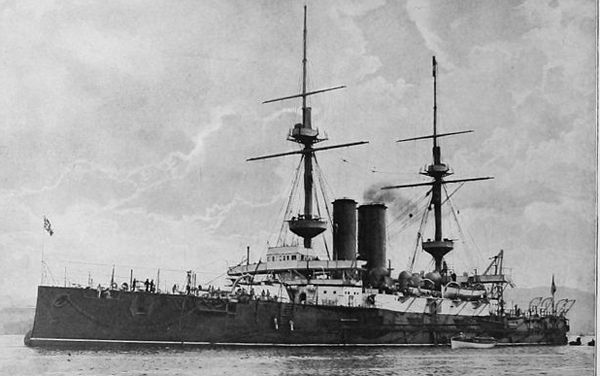
HMS Ocean in 1900
HMS Ocean
HMS Ocean was based in the Mediterranean, then in the Home Fleet and in the war in Pembroke. At the beginning of the war, he was sent to Queenstown in Jamaica, then to the East Indies. In November, he was in the Persian Gulf, then served in the Mediterranean, and fought the Dardanelles from February to March 1915. On the 18th, he struck a mine, after having wandered, hit by large Turkish caliber. It sank in three hours, leaving almost all of its surviving crew to evacuate.
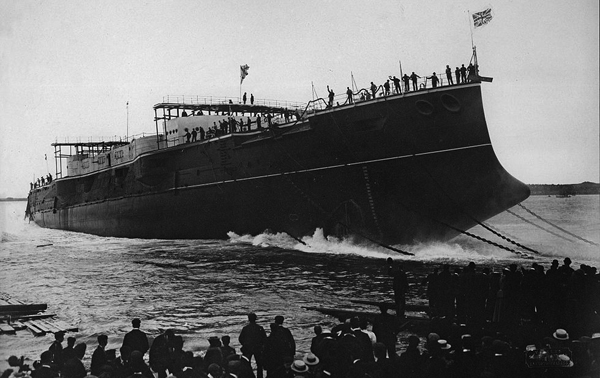
Launching of HMS Vengeance
HMS Vengeance
HMS Vengeance served in Channel, then in Home Fleet. Unhappy in his career, he hit a freighter, then ran aground in the Thames, and hit the destroyer Biter in 1910. In 1914 they still served as a training ship for gunners. He served then in the Atlantic with the 8th squadron of line, and in November 1914, operated against Cameroon, German colony. He was then detached to Egypt, then to Cape Verde. He was Admiral De Robeck’s flagship in Gibraltar, before joining the Dardanelles. He fired the forts of Cape Helles, covered the landings, before returning to Egypt. He then rallied to the East Indies, then returned to Egypt, opera again on the East African coast, and then in South Africa. He returned to Devonport in 1917 and was rearmed and kept as a ship-prescription. It was dropped from the lists in 1919, and demolished in 1921.

Artist’s Rendition of HMS Canopus
Neptune specifications |
|
| Dimensions | 128,47 x 22,56 x 7,98 m (ft) |
| Displacement | 13,150t, 14,300 Tons FL |
| Crew | 682 Peacetime |
| Propulsion | 2 shafts, 3 TE engines, 20 Belleville boilers, 13,500cv. |
| Speed | 18 knots () |
| Range | 6,330 nautical miles (11,720 km; 7,280 mi) at 10 knots (19 km/h) |
| Armament | 4 x 305, 12 x 152, 10 x 76, 6 x 47, 4 x 457 mm TT (sub). |
| Armor | Belt 152, Battery 254, Barbettes 305, turrets 203, blockhaus 152, decks 51 mm. |
Sources/Read More
Friedman, Norman (2011). Naval Weapons of World War One. Barnsley: Seaforth
Burt, R. A. (2013) [1988]. British Battleships 1889–1904. Barnsley: Seaforth Publishing
Gardiner, Robert, ed. (1979). Conway’s All the World’s Fighting Ships: 1860–1905. London: Conway Maritime Press
Canopus-class on Wikipedia

 Latest Facebook Entry -
Latest Facebook Entry -  X(Tweeter) Naval Encyclopedia's deck archive
X(Tweeter) Naval Encyclopedia's deck archive Instagram (@navalencyc)
Instagram (@navalencyc)





 French Navy
French Navy Royal Navy
Royal Navy Russian Navy
Russian Navy Armada Espanola
Armada Espanola Austrian Navy
Austrian Navy K.u.K. Kriegsmarine
K.u.K. Kriegsmarine Dansk Marine
Dansk Marine Nautiko Hellenon
Nautiko Hellenon Koninklije Marine 1870
Koninklije Marine 1870 Marinha do Brasil
Marinha do Brasil Osmanlı Donanması
Osmanlı Donanması Marina Do Peru
Marina Do Peru Marinha do Portugal
Marinha do Portugal Regia Marina 1870
Regia Marina 1870 Nihhon Kaigun 1870
Nihhon Kaigun 1870 Preußische Marine 1870
Preußische Marine 1870 Russkiy Flot 1870
Russkiy Flot 1870 Svenska marinen
Svenska marinen Søværnet
Søværnet Union Navy
Union Navy Confederate Navy
Confederate Navy Armada de Argentina
Armada de Argentina Imperial Chinese Navy
Imperial Chinese Navy Marinha do Portugal
Marinha do Portugal Mexico
Mexico Kaiserliche Marine
Kaiserliche Marine 1898 US Navy
1898 US Navy Sovietskiy Flot
Sovietskiy Flot Royal Canadian Navy
Royal Canadian Navy Royal Australian Navy
Royal Australian Navy RNZN Fleet
RNZN Fleet Chinese Navy 1937
Chinese Navy 1937 Kriegsmarine
Kriegsmarine Chilean Navy
Chilean Navy Danish Navy
Danish Navy Finnish Navy
Finnish Navy Hellenic Navy
Hellenic Navy Polish Navy
Polish Navy Romanian Navy
Romanian Navy Turkish Navy
Turkish Navy Royal Yugoslav Navy
Royal Yugoslav Navy Royal Thai Navy
Royal Thai Navy Minor Navies
Minor Navies Albania
Albania Austria
Austria Belgium
Belgium Columbia
Columbia Costa Rica
Costa Rica Cuba
Cuba Czechoslovakia
Czechoslovakia Dominican Republic
Dominican Republic Haiti
Haiti Hungary
Hungary Honduras
Honduras Estonia
Estonia Iceland
Iceland Eire
Eire Equador
Equador Iran
Iran Iraq
Iraq Latvia
Latvia Liberia
Liberia Lithuania
Lithuania Mandchukuo
Mandchukuo Morocco
Morocco Nicaragua
Nicaragua Persia
Persia San Salvador
San Salvador Sarawak
Sarawak Uruguay
Uruguay Venezuela
Venezuela Zanzibar
Zanzibar Warsaw Pact Navies
Warsaw Pact Navies Bulgaria
Bulgaria Hungary
Hungary

 Bundesmarine
Bundesmarine Dutch Navy
Dutch Navy Hellenic Navy
Hellenic Navy Marina Militare
Marina Militare Yugoslav Navy
Yugoslav Navy Chinese Navy
Chinese Navy Indian Navy
Indian Navy Indonesian Navy
Indonesian Navy JMSDF
JMSDF North Korean Navy
North Korean Navy Pakistani Navy
Pakistani Navy Philippines Navy
Philippines Navy ROKN
ROKN Rep. of Singapore Navy
Rep. of Singapore Navy Taiwanese Navy
Taiwanese Navy IDF Navy
IDF Navy Saudi Navy
Saudi Navy Royal New Zealand Navy
Royal New Zealand Navy Egyptian Navy
Egyptian Navy South African Navy
South African Navy






























 Ukrainian Navy
Ukrainian Navy dbodesign
dbodesign
Boiler pressure should be 300 p.s.i., not Bar (4500 p.s.i.!)
Awesome typo, thanks for spotting it !
-the webaster
They are and always have been the Falkland Islands whilst under British rule NOT the Malvinas , deal in Facts not political correctness .
Too many good men died to keep them known as such , you dishonour thier sacrifice .
I don’t even know why it was called the “malvinas”, must be a translation bug. Fixed. There is no political agenda behind this site.
Rule Britannia.